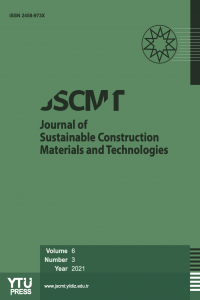Modeling of Damage Evolution and Fracture in 5182 H111 Aluminum Alloy
Modeling of Damage Evolution and Fracture in 5182 H111 Aluminum Alloy
This paper presents results of a numerical modeling of ductile fracture and failure of elements made of 5182H111 aluminum alloys subjected to dynamic traction. The analysis was performed using Johnson-Cook model based on ABAQUS software. The aim of the research was to specify and test the mechanical properties during numerical simulations. The experimental test results for the mechanical properties of the studies for steel were presented with a large description of the testing facilities. The test results were used to determine the temperature dependencies of the mechanical properties, yield strength, modulus of elasticity and thermal elongation
Keywords:
Mechanical properties damage, structural steel, aluminum alloy,
___
- Antoun, T., Seaman, L., Curran, D.R., Kane, G.I., Razorenov, S.V., Utkin, A.V. “ Spall Fracture.” Springer, New York. 2003
- Anderson, T.L. “Fracture Mechanics-Fundamentals and Applications,” 2nd ed. CRC Press, Boca Raton,FL. 1995
- Mikkelsen, L.P. “Post-necking behaviour modelled by a gradient dependent plasticity theory.” International Journal of Solids and Structures 34, 4532–4546. 1997
- Li, S., Simonsen, B.C. “Meshfree simulations of ductile crack propagation.” International Journal of Computational Engineering Science 6, 1–25. 2005
- Ren, B., Li, S., Qian, J., and Zeng, X. “Meshfree simulations of spall fracture.” Computer Methods in Applied Mechanics and Engineering 200, 797–811. 2011a
- Ren, B., Qian, J., Zeng, X., Jha, A.K., Xiao, S., and Li, S. “Recent developments on thermo-mechanical simulations of ductile failure by meshfree method.” Computer Modeling in Engineering and Sciences 71, 253–277. 2011b
- Johnson, G.R. and Cook, W.H. “A constitutive model and data for metals subjected to 1176 large strains, high strain rates and high temperature.” In: Proceedings of the 1177 Seventh International Symposium on Ballistics, pp. 1–7. 1983
- Johnson, G.R. and Cook, W.H. Fracture characteristics of three metals subjected to 1179 various strains, strain rates, temperatures and pressures. Engineering Fracture 21, 31–48. 1985
- F. Mata Cabrera, J. Tejero Manzanares, I. Hanafi, A. B. Arenas, I.Garrido, V.Toledano, and M.L.Rubio, “Investigation the deformation and damage scenario under tensile loading of ductile specimens using thermography,” Int.Rev.Appl.Sci.Eng.5(2014), 1, 1–8.
- Achraf Zineb and khamlichi Abdellatif, Francisco Mata Cabrera, “Effects of cycle duration and phasing on thermomechanical Fatigue of Dog-Bone specimens Made form steel.’’American J. of Engineering and applied Sciences 3(4), 740-748 , 010.
- Bauvineau, L., Burlet, H., Eripret, C., and Pineau, A. “Modelling ductile stable crack growth in a CMn steel with local approaches,” in: Proceedings of the first European Mechanics of Materials Conference on Local Approach to Fracture, Fontainebleau, France, pp. 26-38. 09- 11.09.1996
- Bashir Younise, Marko Rakin, Bojan Medjo, and Aleksandar Sedmak ‘’Numerical Simulation for Studying Constraint Effect on Ductile Fracture Initiation Using Complete Gurson Model’’ FME Transactions, 200, Vol. 38, No. 4, 2010.
- V. Vely, G. Bernhart, L. Penezzi, A. Persson and J. Bergström. “Thermal fatigue of a tool steel: Experiment And Numerical Simulation”, 6th International Tooling Conference. Karlstad University, Sweden. pp. 793-814. 2002.
- Rafal Olaf Smerd, “Constutivie behavior of aluminum alloy sheet at high strain rates,” thesis presented to the university waterloo, Ontario, Canada. 2005 50th.
- M. Abendroth, and M. Kuna, “Determination of deformation and failure properties of ductile materials by means of the small punch test and neural networks”, computational materials Science 28 (2003) 633-644.
- Simkins, D.C. and Li, S. “Mesh free simulations of thermo-mechanical ductile fracture. Computational Mechanics 38, 235-249. 2006.
- Başlangıç: 2016
- Yayıncı: Yıldız Teknik Üniversitesi
Sayıdaki Diğer Makaleler
Modeling of Damage Evolution and Fracture in 5182 H111 Aluminum Alloy
El Amri ABDELOUAHİD, Mounir El Yakhloufi HADDOU, El Khamlichi ABDELATİF
Cleanliness of ventilation ducts, indoor space and AHU
Aleš RUBİNA, Olga RUBİNOVÁ, Petr BLASİNSKİ
Hussein HUMAİSH, Bastien RUET, Laurent MARMORET, Hassen BEJİ
Dust analyses in ventilation ducts
Karolina Vyhlidalova, Petr VLČEK, Olga RUBİNOVÁ, Jiří BERNARD
LISI – the House - Living Inspired by Sustainable Innovation
